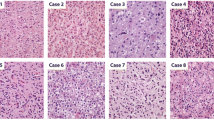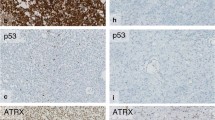Abstract
The genetic and clinical features of glioblastoma with an oligodendroglial component (GBMO), pathologically defined as anaplastic oligo-astrocytoma with necrosis, remain unclear. We investigated the correlation between genetic alterations and clinical outcomes in 19 GBMO patients we have encountered since 1997. Using single nucleotide polymorphism oligonucleotide genomic (SNP) microarrays, we analyzed gene amplification, loss of heterozygosity (LOH), and homozygous deletions in their whole genome. We also analyzed their overall survival (OS). Pathological studies revealed the presence of calcification in 11 and of a cyst in 9 of the 19 patients. Whole-genome analysis using SNP microarrays revealed LOH of chromosome 10 in 11, EGFR amplification in 8, 9p21 (INK4 locus) deletion in 12, PDGFR amplification in 2, and LOH of 1p19q in 2 patients. Median OS was 14 months (average 22.8 months). The pattern of genetic alterations was similar in GBMO and glioblastoma multiforme (GBM) patients, and the clinical outcomes were similar in GBMO and GBM patients.





Similar content being viewed by others
References
Homma T, Fukushima T, Vaccarella S et al (2006) Correlation among pathology, genotype, and patient outcomes in glioblastoma. J Neuropathol Exp Neurol 65:846–854
Hilton DA, Penney M, Pobereskin L et al (2004) Histological indicators of prognosis in glioblastomas: retinoblastoma protein expression and oligodendroglial differentiation indicate improved survival. Histopathology 44:555–560
Kraus JA, Lamszus K, Glesmann N et al (2001) Molecular genetic alterations in glioblastomas with oligodendroglial component. Acta Neuropathol 101:311–320
Miller CR, Perry A (2007) Glioblastoma. Arch Pathol Lab Med 131:397–406
Kleihues P, Burger KD, Aldape DJ et al (2007) Glioblastoma. In: WHO Classification for Tumors of the Central Nervous System. International Agency for Research on Cancer (IARC) Press, Lyon, pp 33–49
Cancer Genome Atlas Research Network (2008) Comprehensive genomic characterization defines human glioblastoma genes and core pathways. Nature 455:1061–1068
Salvati M, Formichella AI, D’Elia A et al (2009) Cerebral glioblastoma with oligodendrogliomal component: analysis of 36 cases. J Neurooncol 94:129–134
Klink B, Schlingelhof B, Klink M et al (2010) Glioblastomas with oligodendroglial component—common origin of the different histological parts and genetic subclassification. Anal Cell Pathol (Amst) 33:37–54
Kawamata N, Ogawa S, Zimmermann M et al (2008) Molecular allelokaryotyping of pediatric acute lymphoblastic leukemias by high-resolution single nucleotide polymorphism oligonucleotide genomic microarray. Blood 111:776–784
Vordermark D, Ruprecht K, Rieckmann P et al (2006) Glioblastoma multiforme with oligodendroglial component (GBMO): favorable outcome after post-operative radiotherapy and chemotherapy with nimustine (ACNU) and teniposide (VM 26). BMC Cancer 6:247
Kraus JA, Glesmann N, Beck M et al (2000) Molecular analysis of the PTEN, TP53 and CDKN2A tumor suppressor genes in long-term survivors of glioblastoma multiforme. J Neurooncol 48:89–94
Cairncross JG, Ueki K, Zlatescu MC et al (1998) Specific genetic predictors of chemotherapeutic response and survival in patients with anaplastic oligodendrogliomas. J Natl Cancer Inst 90:1473–1479
Parsons DW, Jones S, Zhang X et al (2008) An integrated genomic analysis of human glioblastoma multiforme. Science 321:1807–1812
Watanabe T, Nobusawa S, Kleihues P et al (2009) IDH1 mutations are early events in the development of astrocytomas and oligodendrogliomas. Am J Pathol 174:1149–1153
Ichimura K, Pearson DM, Kocialkowski S et al (2009) IDH1 mutations are present in the majority of common adult gliomas but rare in primary glioblastomas. Neuro Oncol 11:341–347
Nobusawa S, Watanabe T, Kleihues P et al (2009) IDH1 mutations as molecular signature and predictive factor of secondary glioblastomas. Clin Cancer Res 15:6002–6007
Acknowledgments
The authors thank Seishi Ogawa for assistance with the SNP microarray analysis and Masayo Obata for help with the pathological techniques.
Author information
Authors and Affiliations
Corresponding author
Rights and permissions
About this article
Cite this article
Nakamura, H., Makino, K. & Kuratsu, Ji. Molecular and clinical analysis of glioblastoma with an oligodendroglial component (GBMO). Brain Tumor Pathol 28, 185–190 (2011). https://doi.org/10.1007/s10014-011-0039-z
Received:
Accepted:
Published:
Issue Date:
DOI: https://doi.org/10.1007/s10014-011-0039-z




